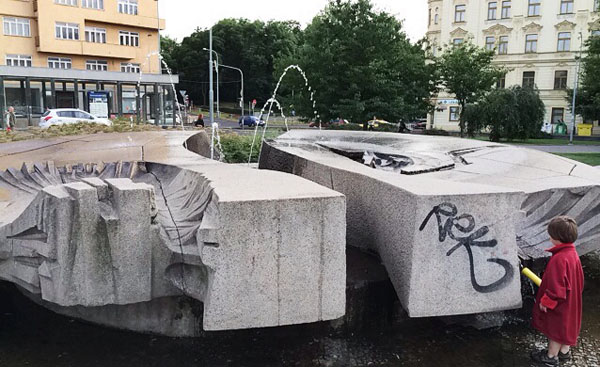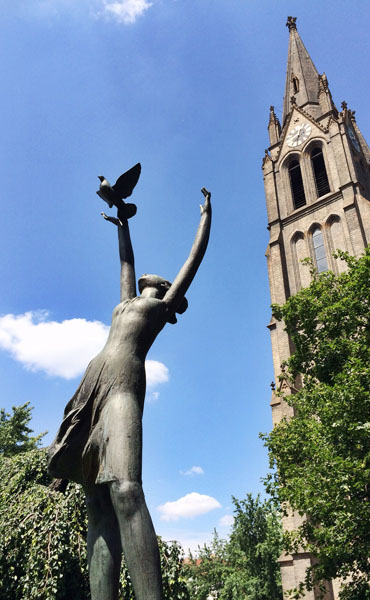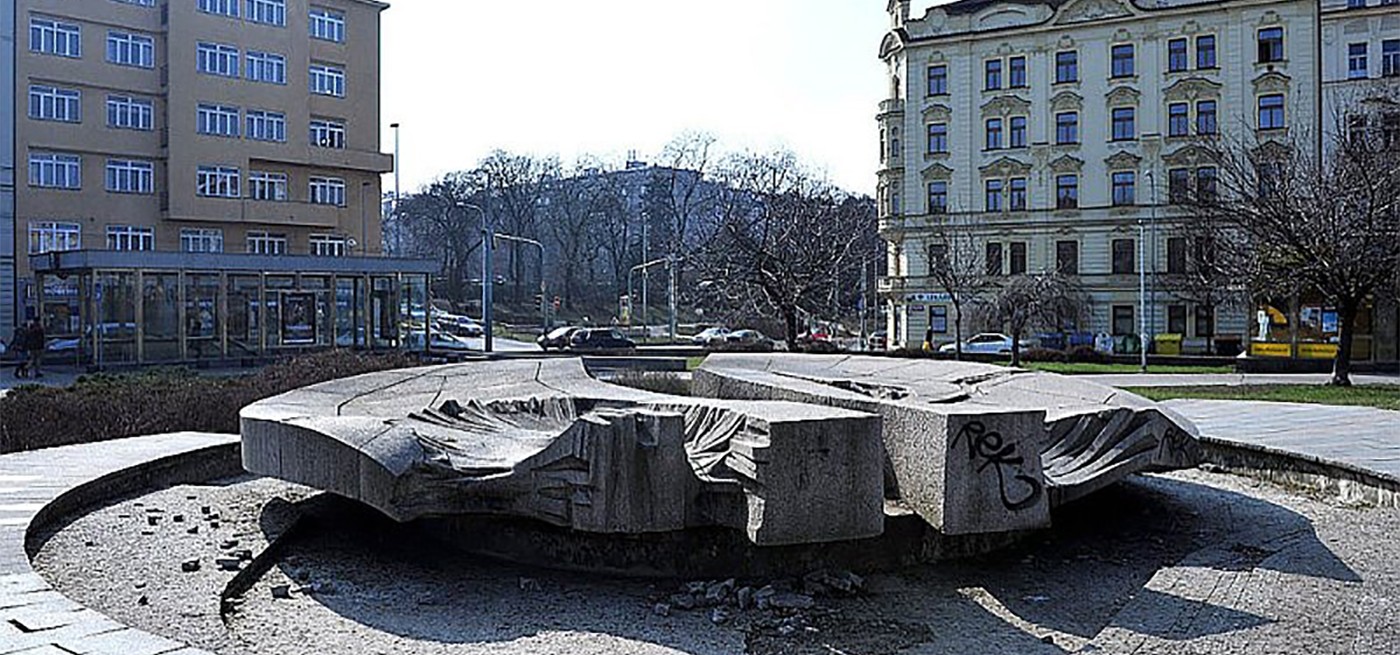Forgotten Art
By Frank Garrett
A new project encourages a second look at the Czech Republic’s late-communist public artworks.
PRAGUE | Czech sculptor Pavel Karous is on a mission. For six years he has been working to preserve public art. But the public, it seems, couldn’t care less. That’s because the art that interests Karous was created during the 1970s and 1980s under the old communist government.
These are no larger-than-life statues of Karl Marx or famous communists from Czechoslovakia. This art differs in both form and content from Socialist Realism, with its mythologizing of laborers. Instead, it depicts much more ideologically neutral themes. Oversized proletariat heroes were replaced during the last decades of communism by abstract flowers, children playing, organic or geometric shapes, and nymphs. Lots of nymphs.
Although some of it was indeed made by great artists, Karous concedes that not all of it is necessarily great art. Its significance lies not in formal or symbolic merit but in its function as a testament to artistic production during the years of Normalization – the period following the 1968 Soviet invasion, when the political and economic liberties of the Prague Spring were brought to an end and Czechoslovakia was brought into line.

Petr Sedivy’s 1981 granite fountain, United Europe, sits in a park near Prague’s Jiriho z Podebrad metro station. A Europe with both Catholics and Protestants united against the Ottoman threat of the 15th century was a vision of Jiri, or George, the Hussite king of Bohemia. Pavel Karous suggests an alternative interpretation is possible: a Europe united despite the historical division between capitalist and communist countries. Though the fountain still works, it is slated to be dismantled.
Karous estimates that from 1968 to the Velvet Revolution of 1989, public funds paid for approximately 1,800 works of this debatable art in the Czech capital alone. Until 1991, a law required that a small share of all new construction budgets – from 1 percent to 4 percent – be set aside for decorative works such as sculptures, fountains, playgrounds, and mosaics.
Such a law might seem typical of the kind of social engineering that went on behind the Iron Curtain, but even today state and city governments around the world endorse this kind of policy. The Czech Republic is one of only a few Central European countries that no longer mandate public art.
Since the state accounted for almost all building projects at the time, there was practically no private property except for garages or possibly weekend cottages. The Housing Act of 1965 required Czechoslovakia to provide homes to its citizens. With the baby boom of the 1960s and 1970s, the pace of construction was stepped up.
Osamu Okamura, an architect in Prague, estimates that during the final years of communism one-third of the Czechoslovak population lived in mass housing estates. The public works that decorated those estates were an integral part of the environment through which a large number of people moved daily. And that art was no afterthought: in the first stages of development, artists were brought in to work closely with architects and urban planners to make the public spaces that linked apartment buildings and transportation hubs more livable and pleasant.
Public art also served an ideological function. In the same way that the space race defined competition between the United States and the USSR, public art in transit and housing centers seemed to provide physical evidence of a standard of living on the rise.
Because there was never a comprehensive guide or catalog of government-funded public artworks under communism, Karous and a team of volunteers first had to come up with their own system. Karous likens the process to picking mushrooms in a dense forest. Equipped only with the knowledge that construction projects legally required some kind of decorative artwork, the team set out to explore every department store, housing estate, factory, medical clinic, and public transportation hub from the period. The result is the recently published Vetrelci a volavky (Aliens and Herons), a 460-page collection of essays and photographs that attempts to document, classify, and analyze Prague’s public art from 1968 to 1989.
In the book, Karous suggests “exhausted” or “late” modernism as the most apt taxonomy for this kind of art. These terms are fitting because of their ambiguity. Modernism proper arrived late in Czechoslovakia, after art history had been preempted by Stalinism’s agenda of Socialist Realism. Late, of course, also implies passed away or deceased. It’s modernism with its vitality sapped.
By working to preserve this art, Karous is hoping to rewrite – and perhaps complicate – the Czech national narrative. “This isn’t mere Soviet kitsch,” he says, estimating that 90 percent of the art found ways around propaganda requirements, making this period a kind of golden age in Czech art history.
Over these two decades, funds were plentiful and ideological constraints were few, relatively speaking. While censors were busy ensuring that the press, literature, and film adhered to official state policy, visual artists were able to sidestep such scrutiny. Even blacklisted artists could participate anonymously. The government was supplied with willing participants who would abide by relaxed restrictions in order to obtain the financial as well as artistic perks of a lucrative commission.

Jiri Krystufek’s 1979 bronze Allegory of Peace stands above Prague’s Namesti Miru metro station.
Because the state considered abstraction neither degenerate nor bourgeois, these artists could work with relatively few restrictions. The art created during Normalization was not only a true public enterprise but also fairly democratic. Anyone who completed his or her art studies was eligible for support. Artists may have had to compromise their artistry to gain such commissions, but that happens under capitalism, too. And just because people participated in the system does not necessarily imply allegiance to it. Can anyone really say that the builders of Europe’s great medieval cathedrals were wholeheartedly devoted to papal authority and the feudal hierarchy?
All post-communist societies still confront the legacies of the recent past. The three main approaches, especially in regard to public art, have been preservation, commemoration, and iconoclasm. In preservation, positive value is ascribed to something from the past so as to keep it around for the future. In commemoration, negative value is ascribed to something from the past so as to remind people today how terrible it was. While preservation can be understood as a form of celebration, commemoration can be seen as a critical act.
The challenge to preserve public art from the period of Normalization can be contrasted with the impulse to commemorate, for example, the death of Jan Palach by way of plaques, memorials, and statues. Palach was the student who set himself on fire in 1969 to protest the Soviet occupation. On the one hand we value what was created under extraordinary circumstances, on the other the way in which a dissident hero challenged those circumstances.
Both camps have their heroes and villains. But heroism and villainy never take place in a vacuum. Trying to make sense of how this dynamic plays out in the public sphere, and beginning to ask these questions 25 years after the Velvet Revolution, does not generate a simple path forward – especially when the attempt means contending with those who would rather forget the past altogether.
Ideology most influences the iconoclasts, who see little of value in the recent past and ascribe worth only to the present or the future. This group refuses to admit that communism ever benefited the community in any way. They willfully forget, it seems, that communism was always more than constraints imposed by an occupying, imperial nation. History corroborates that before Marx, Europeans wanted to be buried with the Bible; after, with the Manifesto.
Even among the iconoclasts who would prefer a landscape wiped clean of all communist traces, including state-funded art and architecture, there’s not a lot of force or hostility in the movement. Complicating the situation further is the fact that in many cases this art has neither a clear provenance nor a current owner. Originally funded by the communists for “the people,” these works were handed over to the townships, suburbs, and neighborhoods where they stood after the shift to capitalism. Most municipal officials don’t have an accurate catalog of their area or any idea as to the value, either artistic or monetary, of a work.
Karous is part of a larger group of people across Central Europe now asking what role the culture created under communism will play in the future of their countries. The 25th anniversary of the Velvet Revolution offers the Czech Republic a chance to reassess its relationship to recent history, but as historian Ondrej Matejka notes, the Czechs have yet to come to terms with that history.
Matejka, the deputy director of the Institute for the Study of Totalitarian Regimes, says that in the simplistic anti-communist mood of today, Czechs cling to a dysfunctional narrative regarding their recent past. “According to this perspective, we have a simple equation: dissidents equal heroes. If you participated and worked within the confines of the communist government, then you’re tainted. But it’s not that simple.”
As a historian, he is keen to point out that there is still no consensus about the meaning of the Czech Republic’s communist past. “Czechs consider communism a criminal regime without attempting to understand the ways in which Czechs themselves legitimized that regime – criminal or not,” he says.
Matejka calls on Czechs to reflect on the communist era. He maintains that history cannot be a top-down endeavor, an agreed-upon version of the past pronounced from on high. History requires broad public discourse and a society’s commitment to look intently and unflinchingly at itself – a slow, step-by-step process, he acknowledges. But Matejka remains optimistic that the institute’s work can help weave a new narrative regarding national identity.
It’s not just a psychological, sociological, or historical concern, but a legal one as well. Many of the neighboring countries in Central Europe enacted thorough lustration laws that barred former communist leaders from serving in the new government, as a means of achieving some degree of justice. The Czech Republic merely blacklisted those who had collaborated with the secret police. No genuine attempt to bring anyone to justice was made, and the quasi-lustration process became dangerously politicized.
Karous himself still confronts almost daily accusations of being a communist sympathizer. He describes the current situation as “primitive anti-communism,” saying, “People would prefer a tabula rasa, a slate wiped clean of the communist past.” He estimates that already 450 Normalization-era sculptures have been destroyed, either intentionally or by neglect. He is even unable to discuss his passion with his parents, who, he says, reject the notion that anything good came about under the old government.
Even more daunting to artists and arts activists is the fact that these days there is little official support for the art community. “It’s impossible to create public art now,” laments Karous, who is critical of the dominant neoliberal economic model. With changes in politics and society after the Velvet Revolution came changes in aesthetics. Fine arts organizations, once part of the vast governmental bureaucracy, were either dissolved or privatized. Artists had to learn to fend for themselves, competing with a vast array of new consumer goods.
The Czech Republic of today lacks both public support for the fine arts and a transparent process for commissions. Karous estimates that over the past 25 years the municipal and national governments have funded only about 56 public art projects, compared with almost 2,000 in the prior two decades during Normalization. It would be easy for artists to look back longingly at life under communism.
Karous is not blindly nostalgic for the past. To him, the fact that this art was created under a communist regime is beside the point. He insists, however, that the public support for and availability of art during that time should be celebrated. “This was a time, despite the politics, when artists enjoyed considerable freedom and substantial material support,” he says. “This work belongs to the Czech people. It should be a source of national pride.”
If Not Socialist Realism, What Is It, Exactly?
Pavel Karous confesses that part of the problem is deciding what to call the art he is cataloging.
“Public art” is too generic – and because it was created under communism, the word “public,” much like “people’s,” leaves a sour taste in the mouths of Central Europeans, who mostly assume it’s nothing more than communist propaganda. Others have suggested 4 Percent Art to tie it to the legal requirement that guaranteed its creation in the first place. Normalization Art seems a bit unwieldy. Monumentalism, which simply denotes the fact that these works were meant as public monuments, tends to imply that we’re again dealing with monolithic Soviet heroes. This art is often described as Brutalist, but this term becomes more and more imprecise the more it’s misused by armchair art critics. At the time, those envied artists who received government commissions were derided as “Sierralists” because with their earnings they could afford one of the few Western cars then available – the Ford Sierra. Karous’ suggestion – exhausted modernism – seems the most adequate way to classify this art. While Western European and American postmodernists of the 1970s and 1980s had rejected the abstracted and idealized forms of nymphs, children, and flowers, the Czechoslovaks continued to employ these over-used forms past the point of exhaustion.
Story and photos by Frank Garrett, a former Fulbright scholar and a writer and researcher specializing in Central Europe. He tweets at @limmoraliste and blogs at http://www.mycrashcourse.net.
Frank Garrett conducted research and wrote the first draft of this article during the Tales of Transition foreign correspondent course held in the summer of 2014. The article was later published on TOL in December 2014.
 Education
Education